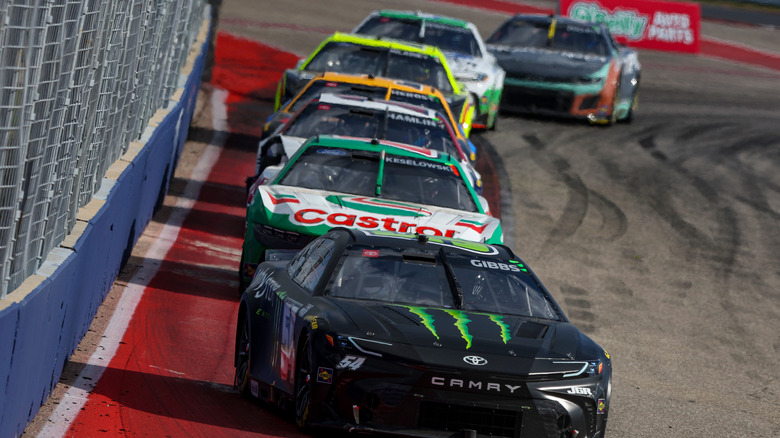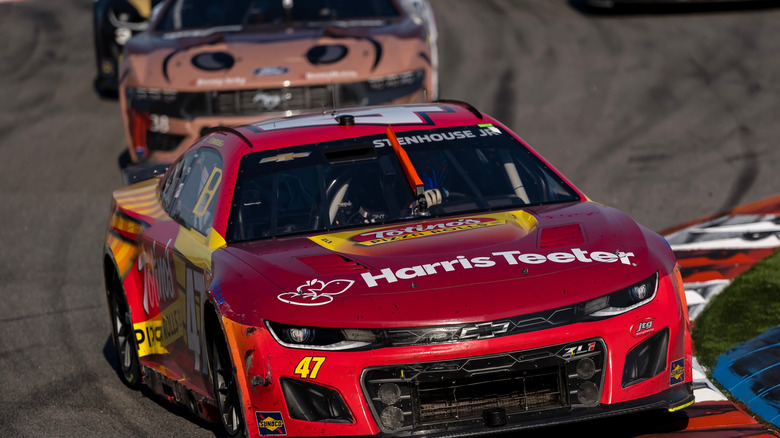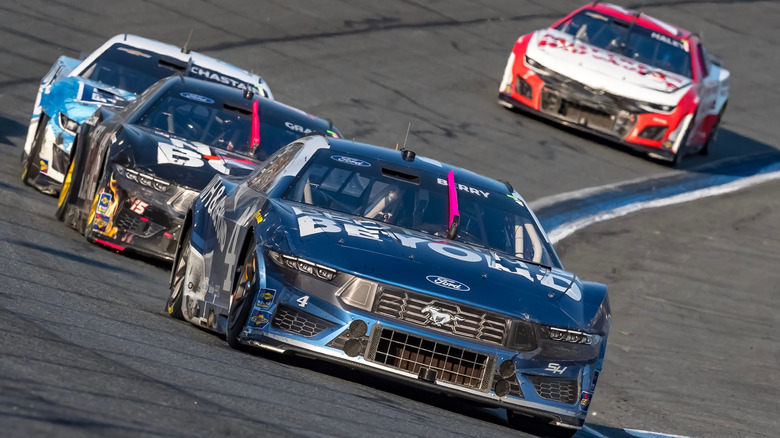While historically NASCAR was known as a showcase between the best each automaker could bring to race day, these days the sport more closely resembles a spec racing series. That means each car on the grid features near-identical bodywork, engines, transmissions, and so on, with only highly-specific alterations allowed according to the rule book. These rules continue evolving, with modern stock cars now featuring actual headlights and a functioning windshield wiper, although it’s often not used for its named purpose. But if you have a wiper that doesn’t wipe the windshield, why is it there? The short answer is that a NASCAR racing car’s windshield wiper sometimes acts as an aerodynamic device. Teams orient the wiper arm in a specific way and build it to attain a specific air disturbance pattern, sculpting the path the air takes as it streams over the car’s roof.
Advertisement
It’s actually a relatively common practice in various racing series to place a single wiper vertically; this minimizes the how much of the car’s surface is exposed to wind. In other words, it’s not vertical because it’s sculpting the air, instead this position provides the least amount of air resistance. NASCAR takes a complex approach, utilizing the windshield wiper as an additional tool to redirect air where teams want it. These subtle changes make minuscule differences in lap times, but when everyone’s using essentially the same car those fractions of seconds quickly add up. Having the right setup can make or break a race, and paying attention to these granular details is what distinguishes a good setup from a great one.
Advertisement
What the rule book says (and doesn’t say)
Some of NASCAR’s most memorable moments depended on teams bending the rules as much as possible to gain any advantage they could find. These adjustments depended on a variety of weird and wacky setups, from creative suspension designs to older tricks like shifting the entire chassis over to one side for better weight distribution. If you can think of it, a NASCAR team has probably done it. As a result, the modern rule book reads more like a compilation of bug fixes than a straightforward list of do’s and don’ts. It’s hard to know for sure, though; the actual NASCAR rule book is kept secret, unlike the publicly available FIA and GT World Challenge regulations. Sadly, this secrecy means that we’ll never know the letter of the law regarding elements like the windshield wiper.
Advertisement
We can gather two specific guidelines based on outside sources and observation, however. The first is that teams are allowed to modify the shape of the wiper frame and blade. This includes eliminating the blade altogether and crafting specialized forms around the wiper arm to generate desired effects. According to Fox News, the 2022 rule book stipulated that these elements could be no greater than 1.5 inches wide and 2.5 inches tall. Another known guideline is that wipers can only be used on road courses, not the high-speed ovals. We know that NASCAR wipers have motors installed behind them as well, so they are functional. But they remain in a fixed position for the duration of the race, which is set by the individual teams. Let’s see how this small part has a big effect.
Advertisement
The aerodynamic principles behind NASCAR wipers
Individual setup largely determines exactly how fast a NASCAR stock car can go. Teams start with essentially the same chassis, body, and powertrain, and small adjustments and upgrades make the difference between a checkered flag and a back-of-the-pack finish. Tactics vary among the teams and circuits, with vehicles altered each week as the championship moves to new tracks. Adjustments include different gear ratios on the special manual transmissions used in NASCAR racing, suspension tweaks, and tuning adjustments to maximize the horsepower output of stock car engines. However, many aspects are standardized in the name of safety and a level playing field. For example, 2022 guidelines stipulated a maximum rear spoiler height of 4 inches following multiple accidents. Regulations apply to the wipers as well, in the sense that each car must have the arm and motor installed on road courses to clear the windshield during bad weather.
Advertisement
But it’s up to individual teams to design the arm and choose where to let it rest on the windshield, which is why many of them are so blocky and prominent. While they may look simple, NASCAR bodies are aerodynamically quite complex. The best teams and drivers utilize the physics behind aerodynamics to great effect, fine-tuning downforce to make their cars suitable to each track. In the interest of safety, NASCAR bodies sport various additions to help stabilize the cars; like vertical shark fins running front-to-back on the roof. You’ll see these on many other racing and performance cars; they’re designed to redirect airflow, keeping the car on its intended line. The wiper acts as an extension of these fins, guiding the airflow over the car’s roof. The resulting increase in downforce is why the wipers aren’t used on oval tracks, where outright speed is king.
Advertisement











